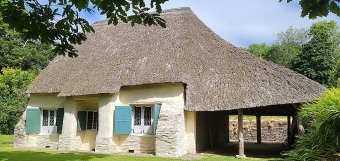Come to good in the countryside of Cornwall
QUAKERS, MEMBERS OF The Society of Friends are Christians who believe that worship should rely on the guidance of the Holy Spirit without the intercession of ordained ministers and without practising outward rituals. The Quakers worship one to one with God without any external ‘frills’. The Quaker movement was founded by George Fox (1624-1691) in about 1652.
Fox travelled around England, Europe, and North America, encouraging people to adopt his method of worship. In 1656, he came to Cornwall. While there, he was arrested for blasphemy several times. Nevertheless, many Cornish people were keen to hear what he had to say, and became his followers. Soon after his visit, groups of Quakers began to form in Cornwall. One of them began meeting in a farmhouse near to the hamlet called Come-to-Good in about 1653. Then, they began renting another building nearby. When this began to disintegrate in 1707, they raised money to build a new Meeting House: a simple thatched cottage, which was completed in about 1710. This humble edifice is still in use for worship meetings today. It stands in Come-to-Good.

The historicengland.org.uk website noted:
“The Meeting House was built in 1710 using funds’ raised from Quaker subscribers in 1707 and 1710. … Research by Mr Withers of Penelewey Barton shows that the farm, including the land on which the meeting house stands, was owned by James Mayo, a Quaker, and was later leased to Vyvian, whose name with the date 1716 is scratched on one of the window panes at the farmhouse. In spite of the C20 porch on the west end, this little meeting house has been remarkably unaltered since the C19 and still retains much of its original character and fabric.”
We visited the Meeting House in early July 2024. Sadly, we could not enter it because it was locked up. So, we were unable to see its simple interior, which has remained almost unchanged since the place was first used. From the road, the Meeting House looks much as it would have when it was built. A small extension with an entrance hall, kitchen, and toilets was added to the rear of the old building in 1967.
There is a small Quaker burial ground near the Meeting House, but we did not notice it because the burial mounds were levelled in the 1940s. One of the people buried there is a Quaker preacher, Catherine Payton Phillips (1727-1794), who, like George Fox, travelled in the British Isles, Continental Europe, and the North American colonies. In 1772, she married William Phillips, and lived with him in his home in Redruth (not far from Come-to-Good).
As for the hamlet’s name, Come-to-Good, it is currently believed that the place was only called that after the formation of the local Quaker’s meeting group. Although it is only a small building, which hardly rivals some of Cornwall’s other attractions, it is a pleasant, peaceful place to visit in the heart of the Cornish countryside.



